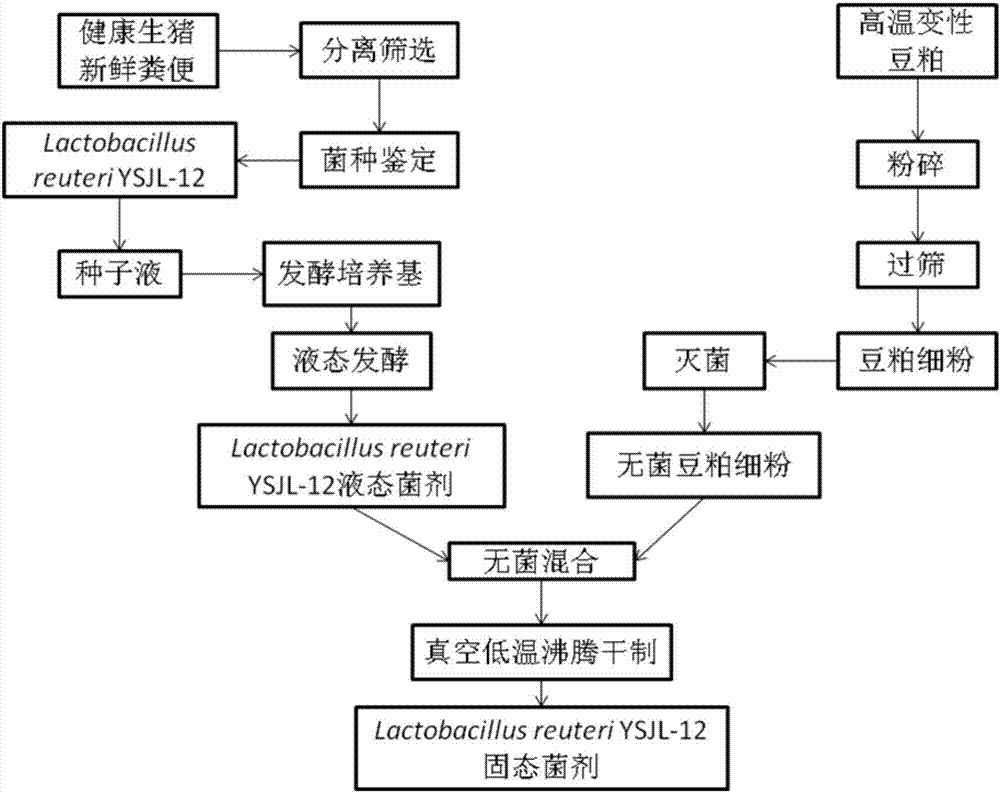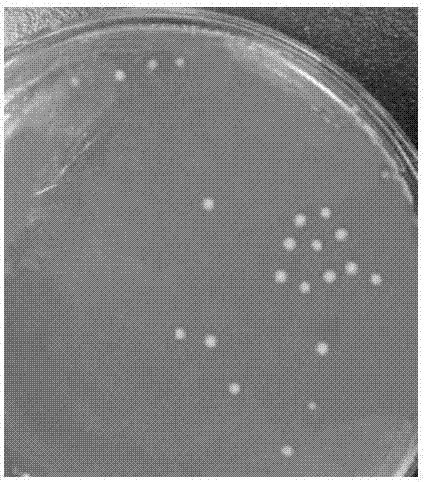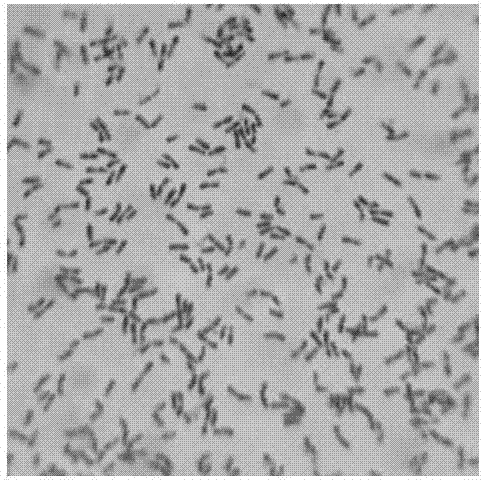Swine-origin lactobacillus reuteri and prepared solid probiotics
A technology of porcine-derived Lactobacillus reuteri and probiotics, applied in bacteria, microorganisms, microorganisms and other directions, can solve the problems of high degree of protein denaturation, low cost of unfavorable culture medium, low digestion and utilization rate, etc. The effect of reducing the cost of green pig breeding and high viable count
- Summary
- Abstract
- Description
- Claims
- Application Information
AI Technical Summary
Problems solved by technology
Method used
Image
Examples
specific Embodiment approach 1
[0022] Specific embodiment one: the separation and screening of bacterial strain
[0023] Isolation and screening of acid producing strains:
[0024] Take an appropriate amount of fresh manure from healthy sows and add it to a sterile container, seal it immediately, and bring it back to the laboratory under ice-cold conditions. Under sterile conditions, take a little of the above-mentioned fresh feces and add them to a sterile water conical flask with glass beads, shake well, take 1 mL and add 9 mL of sterile water, mix well, and sequentially dilute to 10-6, and take each gradient sample solution Pour 1mL into a sterilized empty plate, then pour 15mL-20mL / plate of the separation medium that has been sterilized and cooled to about 45°C and melted, shake it horizontally, put it upside down in a constant temperature incubator after solidification, and keep it at 37°C for 2-3 days . Pick a single colony that turns red around it and puncture it into the sterilized semi-solid MRS ...
specific Embodiment approach 2
[0032] Specific implementation mode two: identification of strain morphology, physiology and biochemistry
[0033] Morphological, physiological and biochemical tests and API50CH tests of carbohydrate acid production were carried out on the isolated strains, and the results are shown in Table 1 and Table 2, respectively. Gram-positive strains, see appendix image 3 . According to "Bergey's Handbook of Systematic Bacteriology", "Handbook of Common Bacterial System Identification" and relevant research papers in International Journal of Systematic and Evolutionary Microbiology, it was initially identified as Lactobacillus reuteri.
[0034] Table 1 Physiological and biochemical test results of strain Lactobacillus reuteri YSJL-12
[0035]
[0036] Table 2 Results of carbohydrate fermentation acid production (API50CH) of strain Lactobacillus reuteri YSJL-12
[0037]
specific Embodiment approach 3
[0038] Specific embodiment three: 16SrRNA gene sequence analysis method to identify bacterial strains
[0039] Strain genome extraction: Extract the genome of the isolated strain according to the TIANamp Bacteria DNA Kit Bacterial Genome DNA Extraction Kit, and perform 1% agarose gel electrophoresis detection.
[0040] 16SrRNA gene PCR amplification: primer 1 799F 5'-AACAGGATTAGATACCCTG-3' and primer 2 1492R5'-GGTTACCTTGTTACGACTT-3'. Reaction system (25uL): 10×PCR buffer 2.5uL, dNTP (2.5mM) (TaKaRa) 2uL, 799F (10pmol / uL) (invitrogen) 0.1uL, 1492R (10pmol / uL) (invitrogen) 0.1uL, Taq polymerase (5U / uL) (TaKaRa) 0.125uL, Templet (extracted DNA) 0.5uL, ddH2O to 25uL. Reaction conditions: pre-denaturation at 94°C for 5min, denaturation at 94°C for 1min, refolding at 52°C for 1min for 30cycles, extension at 72°C for 1min, and final extension at 72°C for 10min. After the PCR reaction, use 1% agarose gel electrophoresis to detect the PCR product .
[0041] 16SrRNA gene amplified fr...
PUM
 Login to View More
Login to View More Abstract
Description
Claims
Application Information
 Login to View More
Login to View More - R&D
- Intellectual Property
- Life Sciences
- Materials
- Tech Scout
- Unparalleled Data Quality
- Higher Quality Content
- 60% Fewer Hallucinations
Browse by: Latest US Patents, China's latest patents, Technical Efficacy Thesaurus, Application Domain, Technology Topic, Popular Technical Reports.
© 2025 PatSnap. All rights reserved.Legal|Privacy policy|Modern Slavery Act Transparency Statement|Sitemap|About US| Contact US: help@patsnap.com



